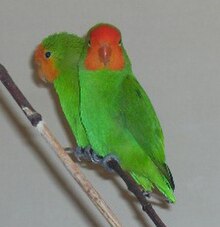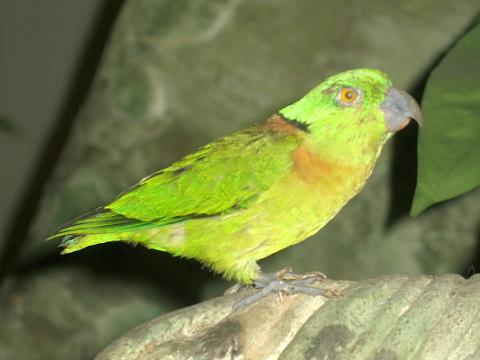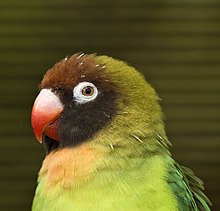All of the nine agapornis species can be found in the wild in Africa and the island of Madagascar.
There are no agapornis species that are extinct, all exist in the wild. Just because some of the species are not kept in captivity it does not mean they are extinct.
1) *ROSEICOLLIS – PEACHFACED, ROSY FACED:
The Rosy-faced Lovebird (Agapornis roseicollis), also known as the Peach-faced Lovebird, is a species of lovebird native to arid regions in southwestern Africa such as the Namib Desert. A loud and constant chirper, these birds are very social animals and often congregate in small groups in the wild. They eat throughout the day and take frequent baths. Coloration can vary widely among populations. Plumage is identical in males and females. Lovebirds are renowned for their sleep position in which they sit side-by-side and turn their faces in towards each other. Also, females are well noted to tear raw materials into long strips, “twisty-tie” them onto their backs, and fly distances back to make a nest. They are common in the pet industry.
The Rosy-faced Lovebird is 17–18 cm long with an average wing length of 106 mm and tail length of 44–52 mm. Wild birds are mostly green with a blue rump. The face and throat are pink, darkest on the forehead and above the eye. The bill is horn coloured, the iris is brown and the legs and feet are grey. The pink of the A. r. roseicollis is lighter than of the A. r. catumbella. Juvenile birds have a pale pink face and throat, a greenish fore crown and crown, and the beak has a brownish base.
| Peach-faced Lovebird | |
|---|---|
 |
|
| In Namibia, Africa |
2) *PERSONATUS – MASKED, YELLOW – COLLARED:
The Yellow-collared Lovebird (Agapornis personatus), also called Masked Lovebird or Eye Ring Lovebird, is a monotypic species of bird of the lovebird genus in the parrot family Psittaculidae. They are native to northeast Tanzania, and they have been introduced to Burundi and Kenya.
The Masked Lovebird is a mainly green small parrot about 14.5 cm (5.5 in) long. Its upper parts are a darker green than its lower surfaces. Its head is black, and it has a bright red beak and white eyerings. Yellow on the breast is continuous with a yellow collar and an expansion of yellow over the nape of the neck. Male and female have identical external appearance.
| Yellow-collared Lovebird | |
|---|---|
 |
|
| In Serengeti, Tanzania |
]The Fischer’s Lovebird (Agapornis fischeri) is a small parrot species of the Agapornis genus. They were originally discovered in the late 19th century, and were first bred in the United States in 1926. They are named after German explorer Gustav Fischer.
The Fischer’s Lovebird has a green back, chest, and wings. Their necks are a golden yellow and as it progresses upward it becomes darker orange. The top of the head is olive green, and the beak is bright red. The upper surface of the tail has some purple or blue feathers. It has a white circle of bare skin (eyering) around its eyes. Young birds are very similar to the adults, except for the fact that they are duller and the base of their mandible has brown markings. They are one of the smaller lovebirds, about 14 cm (5.5 in) in length and 43-58g weight.
While most Fischer’s Lovebirds are green, several color variations have been bred. The blue variation is predominant; lacking yellow, it has a bright blue back, tail, and chest, a white neck, a pale grey head and a pale pink beak. This mutation was first bred by R. Horsham in South Africa in 1957, and two years later it was bred by Dr. F. Warford in San Francisco, California. There is a yellow mutation, which first appeared in France. These birds are typically pale yellow with an orange face and a red beak. Lutino (a mutation that is yellow in color), pied, black or dark eyed white, cinnamon, white, and albino mutations have also been bred.
| Fischer’s Lovebird | |
|---|---|
 |
|
| At Ueno Zoo, Japan |
4) *NIGRIGENIS – BLACK CHEEKED:
The Black-cheeked Lovebird (Agapornis nigrigenis) is a small parrot species of the lovebird genus. It is mainly green and has a brown head, red beak, and white eyerings. It is endemic in a relatively small range in southwest Zambia, where it is vulnerable to habitat loss.
The Black-cheeked Lovebird is 14 cm (5.5 in) in length, with mostly green plumage, reddish-brown forehead and forecrown, brownish-black cheeks and throat, orange bib below the throat which fades to yellowish-green, white eye-rings and grey feet. Adult have bright red beaks, while juveniles of the species are similar but with a more orange bill. Vocalizations are loud, piercing shrieks, which are very similar to those of other lovebirds.
Upper body
At San Diego Zoo
5) *LILIANAE – NYASA, LILIAN’S:
The Lilian’s Lovebird (Agapornis lilianae), also known as Nyasa lovebird, is a small African parrot species of the lovebird genus. It is mainly green and has orange on its upper chest and head. It is 13 cm (5 inches) long and is the smallest parrot on mainland Africa. In captivity it is uncommon and difficult to breed. It measures 13 cm (5 inches) long and is mainly green with white eyerings. It has orange on its head, neck and upper chest and has a green rump. Male and female are identical in external appearance.
 |
6) *TARANTA – ABYSSINIAN, BLACK – WINGED:
The Black-winged Lovebird (Agapornis taranta) also known as Abyssinian Lovebird is a mainly green bird of the parrot family. At about 16.5 cm (6.5 inches) long, it is the largest of the lovebird genus, a group of small parrots. The adult male is easily identified by its red forehead, and the adult female by its all green head. They are native to Eritrea and Ethiopia.
The Black-winged Lovebird, with a length of about 16 –16.5 cm (6.25–6.5 inches), is the largest of all the lovebirds. It is sexually dimorphic, as are the Red Headed lovebird and Gray Headed lovebird of the lovebird genus. The dimorphism becomes apparent in juvenile birds after their first molt at about eight or nine months of age. Both the male and female Black-winged Lovebird are mostly green, and only the adult male Black-winged Lovebird has a red forehead and a ring of red feathers around the eyes.
The tail is black tipped and feathers below the tail show a yellowish colour. The rump and feathers above the tail are light green. In the male feathers under the wing are typically black, and in the female the feathers under the wing are typically greenish or brownish black. Both sexes have a red beak and gray feet.

Male at San Diego Zoo, USA
Female in Ethiopia
The Red-headed Lovebird (Agapornis pullarius) also known as the Red-faced Lovebird is a member of the genus Agapornis, a group commonly known as lovebirds. Like other lovebirds it is native to Africa.
The Red-headed Lovebird is 15 cm (6 inches) long. It is a mostly green parrot. It has a well demarcated red area on its head extending from the top of the beak, over the forehead to mid-crown, and extending to the left and right up to the eyelid margins. They have grey feet. The underside of the wings are a lighter green. The female has orange head colouring, which is less well demarcated than the males red head. The adult male has a red beak and the female has a paler red beak.
 |
8) *CANUS – MADAGASCAR, GREY-HEADED:
The Grey-headed Lovebird or Madagascar Lovebird (Agapornis cana) is a small species of parrot of the lovebird genus. It is a mainly green parrot. The species is sexually dimorphic and only the adult male has gray on its upper body. They are native on the island of Madagascar and are the only lovebird species which are not native on the African continent. They are the smallest of the lovebird species. It is somewhat difficult to breed in captivity.
 |
|
| A pair in Madagascar |
9) *SWINDERN – BLACK COLLARED:
The Black-collared Lovebird, Agapornis swindernianus also known as Swindern’s Lovebirdis a small, 13.5 cm (5 in) long, African parrot in the genus Agapornis. It is a mostly green parrot with black band on the back of its neck, and a dark grayish-black bill. Both sexes are similar. It is rarely kept in captivity because of its dietary requirement for a native fig.

Agapornis Breeders & Exhibitors





